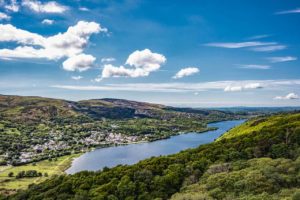The Area
Welcome to the website of the Community Council for Llanberis and Nantperis.
The villages are very popular with tourists and the natural beauty of the area, despite the scars of the industrial past, is world famous as is the Dinorwig quarry itself which is in Llanddeiniolen but is normally referred to as a Llanberis quarry.
 The quarry with its hydro-electric scheme deep inside the mountain is now a tourist attraction as is Gilfach Ddu with the workshops and quarry yard housing the National Slate Museum.
The quarry with its hydro-electric scheme deep inside the mountain is now a tourist attraction as is Gilfach Ddu with the workshops and quarry yard housing the National Slate Museum.
The beauty of the area and the village of Llanberis is seen at its best from this side of Llyn Padarn. Neither the lake nor the lower part of the village is in Parc Cenedlaethol Eryri (the Snowdonia National Park) but the upper part of the village and Nantperis is within the Park.
Nearby is the Padarn Lake Railway that has been extended to reach into the village. This now carries visitors to Penllyn along part of the track that used to carry the slates from the quarry to the port at Y Felinheli.
Before returning to Llanberis, it is worth mentioning that some of the wooded slopes on the north side of the lake are owned by Cyngor Gwynedd Council. This is Parc Padarn and it includes the meadows by the lake and the Quarry Hospital, an important building when the quarry was at its peak.
 The quarries in Dyffryn Peris along with other valleys in the north west are part of a bid to gain UNESCO World Heritage Status.
The quarries in Dyffryn Peris along with other valleys in the north west are part of a bid to gain UNESCO World Heritage Status.
Today there are many modern businesses in the area including medical, health and safety and climbing equipment.
Llanberis developed because of the quarrying industry but people have also been coming here for centuries because of the village’s association with Yr wyddfa (Snowdon). The most popular route up Wales’ highest mountain starts here as does the train that has been going up to the summit since 1896. Once there were three railways in the area but the mainline railway to Caernarfon was closed in the 1960s and now the village bypass and Lôn Las Peris follow the path of the old line. Before the railways and proper roads, boats travelled to Llanberis from Penllyn. At one time, the slates were also taken from the quarries by boat as was the copper ore mined on Snowdon and in Nantperis. Iron ore was also carried to Llanberis over Bwlch y Groes from Betws Garmon.
Nantperis used to be the old Llanberis or Nant Uchaf and this is where the Parish Church is consecrated to St. Peris. It has been rumoured that he was once a cardinal in Rome, but this cannot be substantiated. It is not easy to pin point when the villages’ names became established as we know them today.
 The Parish cemetery surrounds the church at Nantperis with the Community cemetery across the road. This Council manages the cemetery as well as cutting the grass in the Church cemetery twice per season.
The Parish cemetery surrounds the church at Nantperis with the Community cemetery across the road. This Council manages the cemetery as well as cutting the grass in the Church cemetery twice per season.
The inn at Nantperis, the Vaynol Arms although know to the locals as Ty’n Llan, alludes to one of the main landowners of the area in the past. The family of the Faenol estate by Y Felinheli owned the quarry and vast tracts of land in the area. In Llanberis there are several public houses, guest houses, restaurants and cafes. The growth in hospitality grew with the growth in industry and tourism. But people were visiting the area eight centuries ago to Dolbadarn castle, a castle built by one of the Princes of Gwynedd. It is said to have been built by Llewelyn ap Iorweth but there could have been a fort on the site dating as far back as the 6th century. The remains were a popular destination and images have appeared in old travel guides. Amongst the most famous is a painting by JMW Turner painted at the end of the 18th century.
 By the lake in the village car park is a sword which reminds us all of the importance of Dolbadarn castle and the age of Princes. The lake is very popular with many visiting schools and outdoor activities centres. The Council manage the children’s playground by the lake.
By the lake in the village car park is a sword which reminds us all of the importance of Dolbadarn castle and the age of Princes. The lake is very popular with many visiting schools and outdoor activities centres. The Council manage the children’s playground by the lake.
There is a variety of shops, cafes a garage (no petrol) and other businesses including the community venture Menter Fachwen on the Stryd Fawr, the main street. As congregations dwindled, many chapels closed but two chapels and the Church remain open. The village has an impressive community centre. Y Ganolfan is a multi-purpose building well used by the community. Another popular centre is Y Festri which is a smaller venue concentrating mainly on activities for children and young people. Both venues are run by volunteers.
For many visitors, Llanberis is a holiday village or an area for outdoor activities. For the residents it is home and we would like everybody to remember this. We would appreciate considerate parking in designated spaces and proper disposal of litter.
Come and enjoy yourselves but respect the environment and the local community, be aware that there is farming and livestock on the mountains – come back soon..
